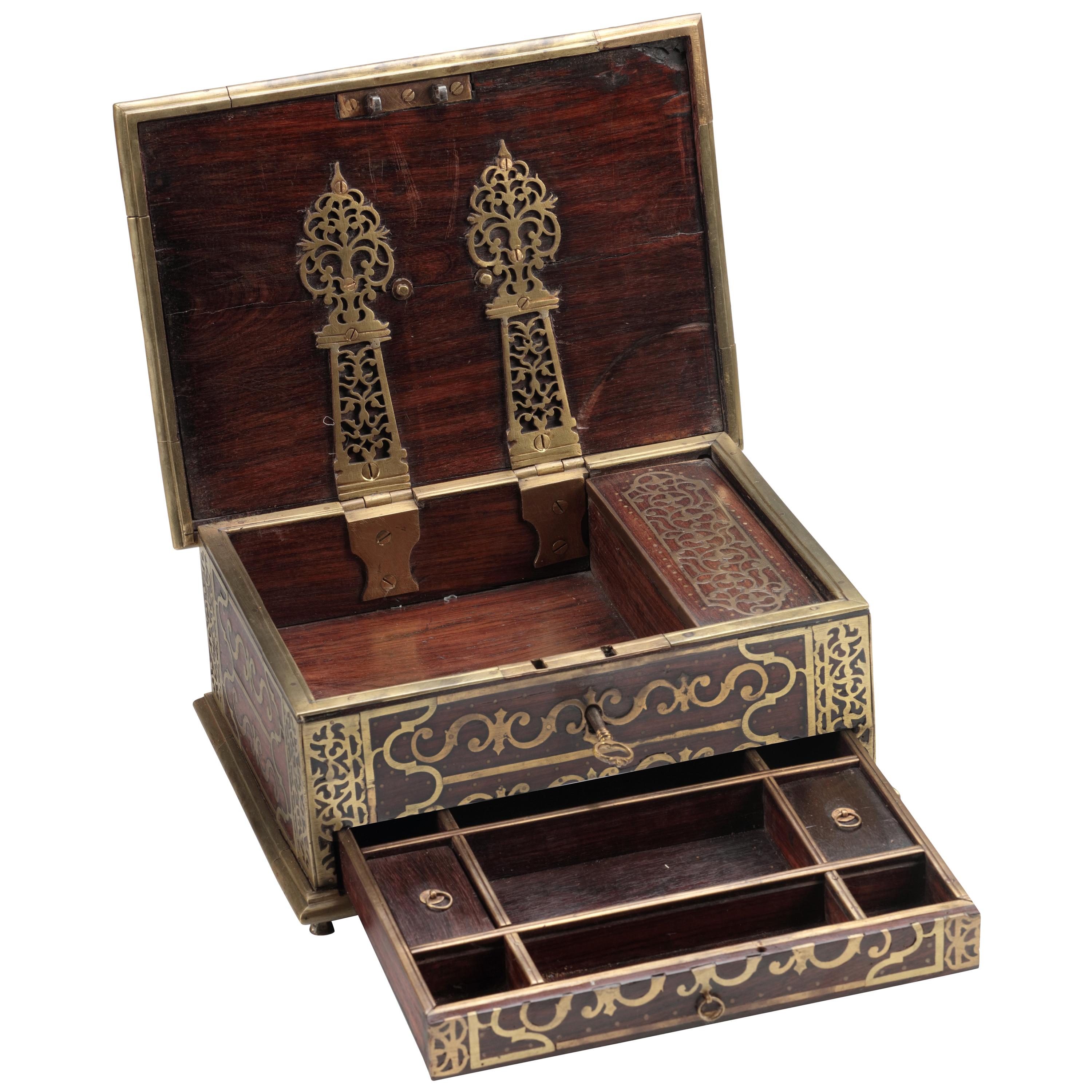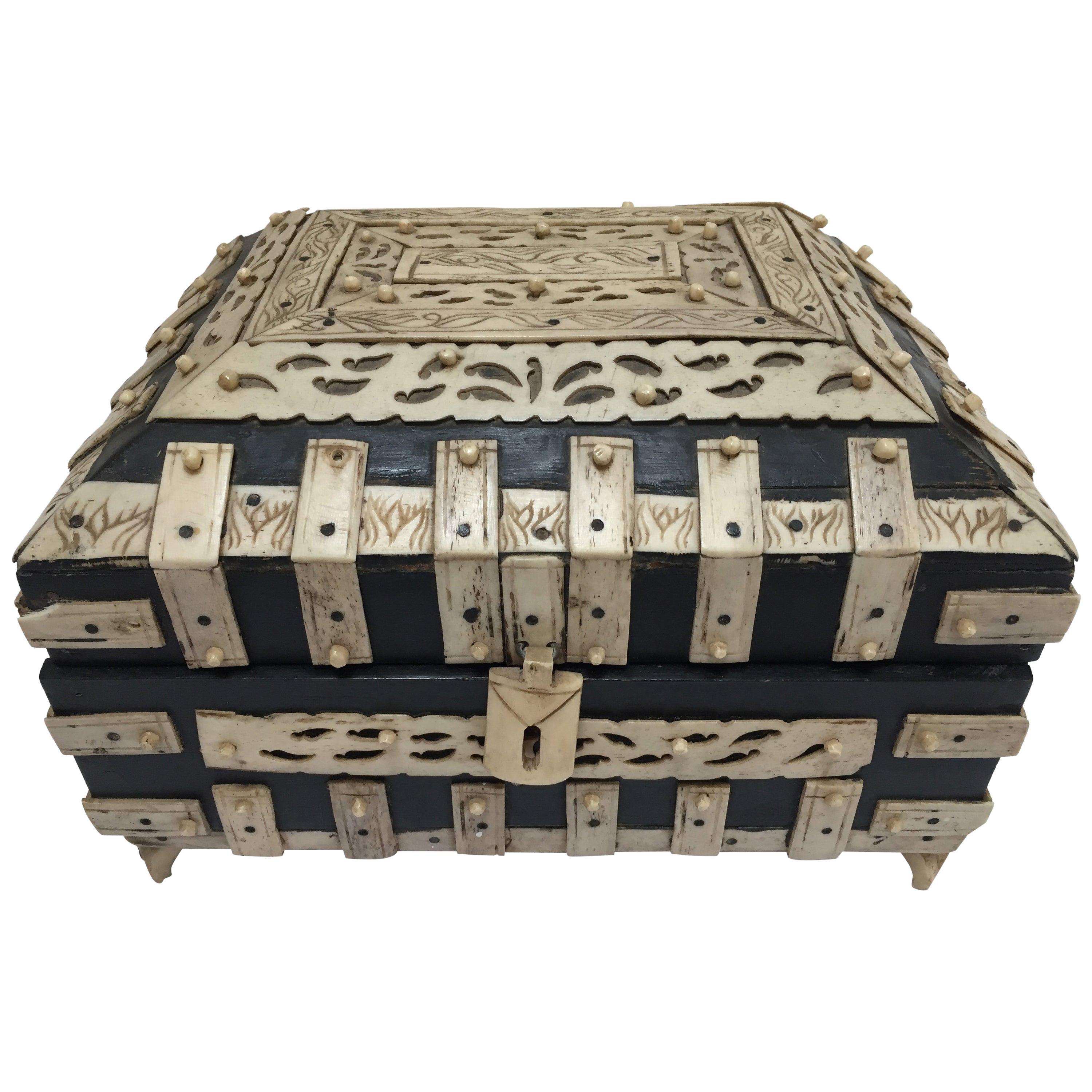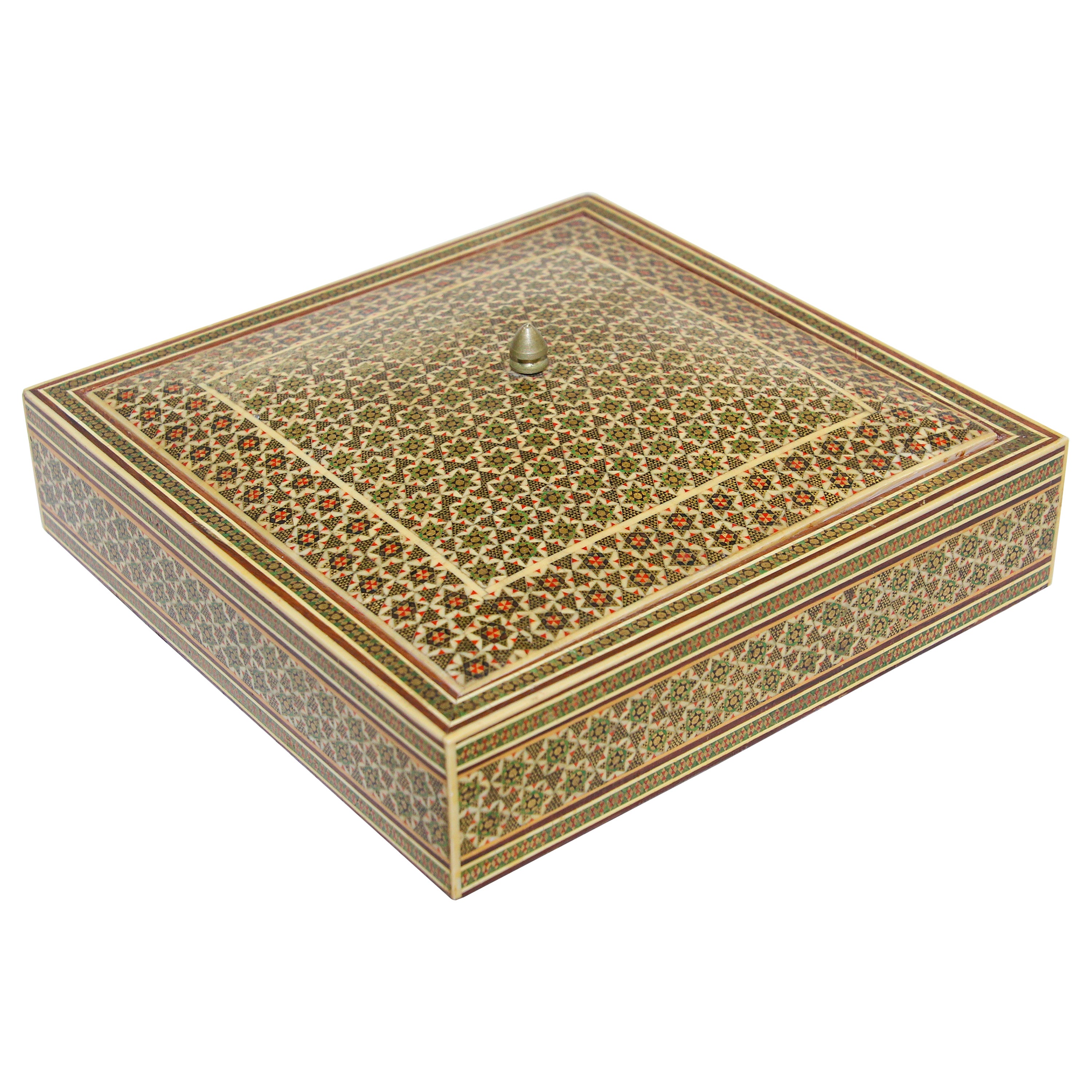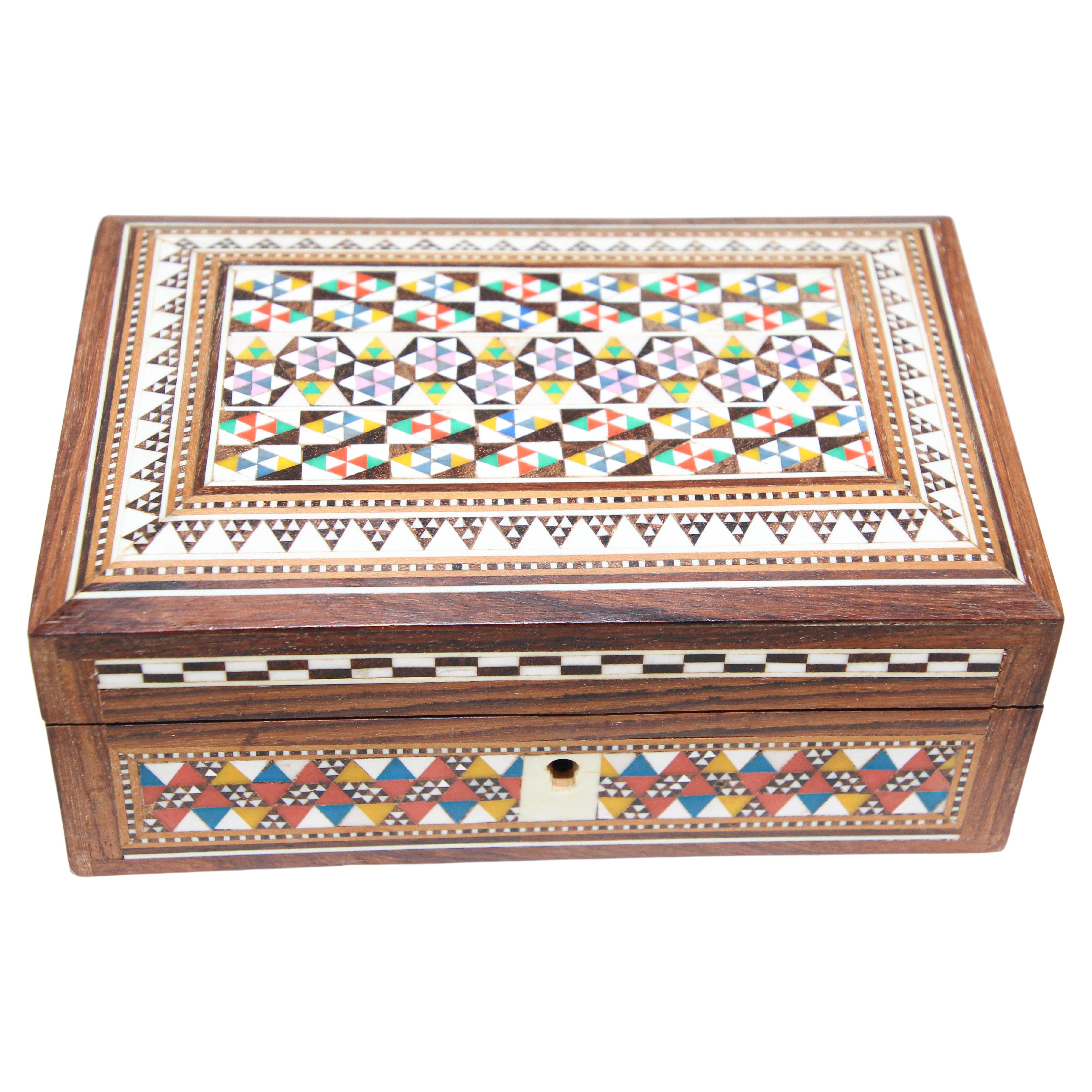Items Similar to 18th century Dutch-Colonial ‘Vizagapatam’ pen-engraved bone inlaid ebony box
Want more images or videos?
Request additional images or videos from the seller
1 of 9
18th century Dutch-Colonial ‘Vizagapatam’ pen-engraved bone inlaid ebony box
About the Item
A large Indian Colonial ‘Vizagapatam’ pen-engraved bone inlaid ebony box
Masulipatnam or Vizagapatam, 2nd half 18th century
H. 10.8 x W. 47 x D. 34 cm
There are a few similar document boxes with fine inlay of small flowers connected by curling vines, many of them with the coats-of-arms of high-ranking VOC-officials engraved on a plaque in the centre of the lid. These boxes have always been thought to have been made in Vizagapatam. However, recently Jan Veenendaal convincingly argued that Masulipatam, about 300 kilometres south of Vizagapatam, and a much more important trade post for the Dutch than Vizagapatam, is much more likely to be the place where this type of box was ordered by the Dutch (Jan Veenendaal, De herkomst van documentenkisten met Nederlandse heraldische wapens van hoge VOC- functionarissen in Azië, Aziatische Kunst, jaargang 49, nr.1, maart 2019, pg. 53-60). The most famous amongst these boxes are those made on order by Jan Albert Sichterman (c. 1736), the Falck family (c. 1735), Jacob Mossel (c. 1740), Galenus Mersen (c. 1740) and Jan van Oordt (c.1740). The present box does not have a family crest in the central oval medallion. However, instead, inside a double ring two lions rampant crowned, on both sides of a large decorative flowering plant, arguably relating to the Dutch national coat-of-arms.
- Dimensions:Height: 4.26 in (10.8 cm)Width: 18.51 in (47 cm)Depth: 13.39 in (34 cm)
- Style:Dutch Colonial (Of the Period)
- Materials and Techniques:
- Place of Origin:
- Period:
- Date of Manufacture:circa 1720-1740
- Condition:Wear consistent with age and use.
- Seller Location:Amsterdam, NL
- Reference Number:1stDibs: LU5458231950892
About the Seller
5.0
Vetted Seller
These experienced sellers undergo a comprehensive evaluation by our team of in-house experts.
Established in 1985
1stDibs seller since 2020
19 sales on 1stDibs
Typical response time: 3 hours
- ShippingRetrieving quote...Ships From: Amsterdam, Netherlands
- Return PolicyA return for this item may be initiated within 7 days of delivery.
More From This SellerView All
- Colonial Islamic Arabian Market Jewelry Box, 18th Century, India/Malabar CoastLocated in Amsterdam, NLAN INDIAN ROSEWOOD AND EBONY BRASS MOUNTED BOX FOR THE ISLAMIC MARKET Malabar Coast, 18th century With a large drawer with several compartments under a lid with two com...Category
Antique 18th Century Indian Islamic Jewelry Boxes
MaterialsBrass
- 17th century colonial Sinhalese ebony two-door cabinet with silver mountsLocated in Amsterdam, NLA splendid Dutch-colonial Sinhalese ebony two-door cabinet with silver mounts Sri Lanka, Kandy, 2nd half 17th century, the mounts later The cabinet with a central drawer with hidde...Category
Antique 17th Century Sri Lankan Dutch Colonial Jewelry Boxes
MaterialsSilver
- Colonial 18th Century Vizagapatam Pen-Engraved Writing Desk with Silver MountsLocated in Amsterdam, NLA Vizagapatam pen-engraved veneered sandalwood portable writing desk with silver mounts India, Coromandel coast, Visakhapatnam, circa 1875 ...Category
Antique 18th Century Indian British Colonial Desk Sets
MaterialsBone, Sandalwood
- 16th-Century Indo-Portuguese Colonial Mother-of-pearl Gujarat CasketLocated in Amsterdam, NLAn exceptional Indo-Portuguese colonial mother-of-pearl veneered casket with silver mounts India, Gujarat, 2nd half of the 16th century, the silver mounts Goa or probably Lisbon Measures: H. 16 x W. 24.6 x D. 16.1 cm An exceptional Gujarati casket with a rectangular box and truncated pyramidal lid (with slopes on each side and a flat top) made from exotic wood, probably teak (Tectona grandis), covered with a mother-of-pearl mosaic. The tesserae, cut from the shell of the green turban sea snail (Turbo marmoratus, a marine gastropod) in the shape of fish scales, are pinned to the wooden structure with silver ball-headed nails. The casket is set on bracket feet on the corners. The masterfully engraved decoration of the silver mounts follows the most refined and erudite Mannerist repertoire of rinceaux and ferroneries dating from the mid-16th century. The high quality and refinement of the silver mounts and, likewise, the silver nails that replaced the original brass pins used to hold the mother-of-pearl tesserae in place indicate the work of a silversmith probably working in Lisbon in the second half of the 16th century. The Indian origin of this production, namely from Cambay (Khambhat) and Surat in the present state of Gujarat in north India, is, as for the last three decades, consensual and fully demonstrated, not only by documentary and literary evidence - such as descriptions, travelogues and contemporary archival documentation - but also by the survival in situ of 16th-century wooden structures covered in mother-of-pearl tesserae. A fine example is a canopy decorating the tomb (dargah) of the Sufi saint, Sheik Salim Chisti (1478-1572) in Fatehpur Sikri in Agra district in the state of Uttar Pradesh, north India. This is an artistic production, geometric in character and Islamic in nature, where usually the mother-of-pearl tesserae form complex designs of fish scales or, similar to the dishes also made using the same technique, with the thin brass sheets and pins, stylized lotus flowers. The truncated pyramidal shape corresponds, like their contemporary tortoiseshell counterparts also made in Gujarat, to a piece of furniture used in the Indian subcontinent within the Islamic world prior to the arrival of the first Portuguese. This shape, in fact, is very old and peculiar to East-Asian caskets, chests or boxes used to contain and protect Buddhist texts, the sutras. A similar chest is the famous and large reliquary chest from Lisbon cathedral that once contained the relics of the city's patron saint, Saint Vincent. Both match in shape, having the same kind of socle or pedestal and bracket feet, and in their engraved silver mountings, featuring the same type of refined, erudite decoration. Their differences lie in the silver borders that frame the entire length of the edges of the chest (both the box and the lid), pinned with silver nails, and on the lock plate, shaped like a coat of arms in the Lisbon example. Given the exceptional dimensions of the reliquary casket...Category
Antique 16th Century Indian Jewelry Boxes
MaterialsSilver
- Splendid Indo-Portuguese Colonial Sculpture of Nagini from Goa, 17th CenturyLocated in Amsterdam, NLA fine Indo-Portuguese inlaid teak wood figure of Nagini India, Goa, 17th century Measure: H. 55 cm (with stand, and with ring for wall hanging) The sculpture can be perceived as such but probably is one of four legs of an Indo-Portuguese contador...Category
Antique 17th Century Indian Jewelry Boxes
MaterialsEbony, Teak
- 18th-century Dutch-colonial Peranakan mother-of-pearl casket with silver mountsLocated in Amsterdam, NLAn Indonesian Peranakan mother-of-pearl inlaid mastic sirih casket with silver mounts Jakarta (Batavia), circa 1720-1730, the silver hinges marked for Batavia, maker’s mark HS or SH...Category
Antique Mid-18th Century Indonesian Dutch Colonial Antiquities
MaterialsSilver
You May Also Like
- Anglo-Indian Vizagapatam Bombay Mughal Style Footed Box With Bone OverlayLocated in North Hollywood, CANice and unusual Indian Mughal style large decorative box, filigree and carved horn. Anglo-Indian footed domed box with exceptional engraved details throughout with filigree and carved veneered bone plaques with arabesque carving. Vizagapatam, late 19th century. History of the Anglo-Indian Boxes Beginning in the early part of the 18th century, Indian artisans made what came to be known as Anglo-Indian boxes for the English residents living in India, who eventually brought or sent them back to England. At the beginning of the 19th century, India began exporting these boxes commercially, although not in any significant numbers until the 1850s. People valued them so highly that manufacturers of tins copied the designs on them in the late 19th and early 20th century. Anglo-Indian boxes fall into four groups: Rosewood or ebony boxes inlaid; sandalwood boxes veneered; sandalwood boxes covered with Sadeli mosaic; and carved boxes often combined with Sadeli mosaic/ The first two categories came from Vizagapatam in East India while the last two came from Bombay in West India. English traders discovered the rich woods and intricate workmanship of Indian artisans, so colonial government officials began to recognize the work of the Indian artists and craftsmen as a source for satisfying the need for furniture and boxes, which would both serve to enhance English households in India. This gave rise to the cabinetmaking workshops in Vizagapatam between Calcutta and Madras. Craftsmen made the first boxes to be decorated with Sadeli mosaic of rosewood or ebony, incised to give further definition to the decoration, directly inlaid into the wood. The shape of the early boxes was either sloping at the front with a flatter section at the back, reminiscent of English writing slopes, or rectangular. Artisans inlaid the borders with stylized floral scrolls and the centers with a single floral motif following a circular or oval symmetrical or asymmetrical pattern. The edging was ornamental and protective, both helped protect the end grain against the weather. Made in Vizagapatam, situated on the south east coast of India, near Madras These exotic boxes...Category
Antique Late 19th Century Indian Anglo Raj Decorative Boxes
MaterialsWood
- Moorish Micro Mosaic Inlaid Jewelry BoxBy RajhastaniLocated in North Hollywood, CAMoorish style micro mosaic marquetry inlaid jewelry box with lid. Intricate inlaid Anglo Indian box with floral and geometric Islamic Moorish mosaic Sadeli design in a square shape form with mosaic inlay and marquetry, very fine artwork, lined in red velvet. Museum collector piece like the one in Doris Duke Islamic Art Museum. The repeating geometric patterns of Sadeli Mosaic are what give it beauty and richness. This decorative technique is a type of micro mosaic featuring repeating geometric patterns. A highly skilled craft, it has had a long history in India and the Middle East with early examples dating back to the 16th century. In the 1800s, it became popular as a decoration on a variety of boxes, card cases, and chess boards imported from India. Since Bombay became a center of making them, they became known as Bombay boxes...Category
Mid-20th Century Indian Agra Jewelry Boxes
MaterialsWood
- Middle Eastern Mosaic Moorish Box InlaidLocated in North Hollywood, CAExquisite handcrafted Middle Eastern Lebanese, Egyptian mosaic marquetry wood box inlaid. Small vintage walnut Syrian style box intricately decorated with Moorish motif designs which have been painstakingly inlaid with mosaic shell and marquetry. Great craftsmanship handmade by artisans in the Middle East, Lebanon or Egypt. Dimensions Height: 2.25 in. Width: 6 in. Depth: 4 in. Circa 1950. Great Middle Eastern Islamic Mosaic...Category
Mid-20th Century Lebanese Moorish Decorative Boxes
MaterialsAbalone, Fruitwood, Shell
- Persian Lacquer Pen Box Hand Painted with Floral DesignLocated in North Hollywood, CAMiddle Eastern Persian style hand painted lacquer pen box in rectangular shape. Decorated with floral designs on black background. Moorish pen box papier maché. Size is 8" x 2" x 1.25" height. Overall good condition. Great Islamic Art collector museum quality piece on this miniature painting on box. Wear consistent with age and use. Nice Mughal Indo Persian pen Box.Category
Mid-20th Century Indian Moorish Decorative Boxes
MaterialsPaper
- Persian Lacquer Pen Box Hand Painted with Floral and Gilt DesignLocated in North Hollywood, CAPersian hand painted lacquer pen box in rectangular shape. Decorated with floral designs on gold background, black interior. Moorish Mughal pen box papier maché with miniature floral painting in the Persian style. Great Islamic Art collector museum quality piece on this miniature painting on box. Nice Mughal Indo Persian pen Box...Category
Early 20th Century Indian Moorish Decorative Boxes
MaterialsPaper
- Handcrafted White Mother of Pearl Inlaid Moorish Octagonal BoxLocated in North Hollywood, CAExquisite handcrafted white mother of pearl inlaid and hand carved lidded box. Small octagonal Anglo Indian decorative box intricately decorated with Moorish motif designs which hav...Category
Mid-20th Century Indian Moorish Decorative Boxes
MaterialsShell, Fruitwood, Abalone, Mother-of-Pearl
Recently Viewed
View AllMore Ways To Browse
Post Box Antique
Cloisonne Calligraphy Brush
Jomon Pot
Rattan Linear Chandelier
Red Coral Prayer Beads
Vintage Phillips Speakers
Wooden Penis
Chinese Carved Ivory Emperor
Jade Peach Tree
Yellow Wo
Chinese Jade Cups
Bone Handled Parasol
Old Japanese Wabi Sabi
Japanese Vintage Matchboxes
Kuruma Tansu
Antique Wicker Planter Antiques
Chinese Bound Foot Shoes
Hetian Jade Bracelet





